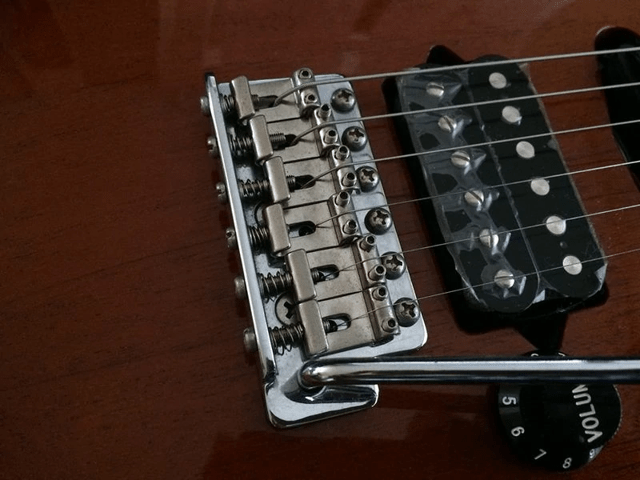The Synchronized Tremolo
 A vintage-style
Synchronized Tremolo.
A vintage-style
Synchronized Tremolo.
Ah, the One Really Good Fender Design. The Synchronized Tremolo, featured on Strats, is a fantastic design, and since its introduction in 1954 it’s become by far the most popular vibrato system in the guitar world. It owes that honor to its many excellent features — unlike a Bigsby or Jazzmaster tailpiece, it takes very little space on the front of the guitar (since all the working parts of the Synchronized Trem are in the back); it has six saddles, each individually adjustable for action and intonation; the tension is very finely and very easily adjustable, by changing the spring arrangement or turning the claw screws in the back of the guitar, and unlike a Floyd Rose, doesn’t require fiddly finetuners and string locks.
TL;DR: It’s easy to use, easy to adjust, and every part of its operation can be adjusted.
Quirks
There’s a common misconception about synchronized trems, popularized no doubt in the Floyd Rose era — that they only allow the player to drop the pitch of the note down, but do not allow for raising the pitch. That’s false.
That misconception stems from the fact that most Synchronized Trems are set up decked — “decking” a bridge of this design means reducing the height and increasing the tension (by adding springs and tightening the claw screws) until it pulls the bridge flush with the body.
A “decked” trem is limited in its rearward travel by the body, and so can only bend notes down in pitch. This has a number of advantages — the tuning is quite stable, since the tension is high enough that it will always try to pull the strings to the right pitch; bending or breaking a string will also not throw your other strings out of tune, and you can detune at any time easily if you so desire.
If you desire the ability to pull notes up, you can also float a Synchronized Tremolo by carefully adjusting its height and the tension so that it floats with a gap between the rear of the bridge and the body, pulled one way by the string tension and the other way by its springs.
A floated trem can bend notes both up and down, but that flexibility comes at a cost. Since it now depends on string tension to keep it in the right place, any change to that tension throws all the strings out of tune — bending a note will make other notes that ring out simultaneously go flat, breaking a string will make the whole guitar go sharp, and you lose the ability to quickly switch to drop D by just detuning one string. The tuning is also much less stable than on a decked trem.
On the other hand, a floated trem is extremely sensitive to the lightest pressure on the vibrato arm, so you can get some very nice, gentle vibrato with small movements, which isn’t quite achievable on a decked trem — Jeff Beck is a master of this technique. Like him, you can also learn to compensate for the tuning instability by gently pulling or pushing notes back in tune using the vibrato arm.
Seriously, go check out Jeff Beck’s vibrato technique. I don’t know any other guitar players who have as complete a mastery of this vibrato system as him.
Variants
There are two main variants of the Synchronized Tremolo and they differ pretty much only in mounting.
At its introduction in 1954, the Synchronized Tremolo was mounted to the guitar body with six screws, one in front of each saddle. This “vintage” variant — referred to as the six-point version — is pictured at the top and is the most common in non-Fender guitars with synchronized trems.
At some point Fender switched from six screws to just two big flathead screws that thread into threaded brass bushings in the body rather than screwing directly into the wood. This is known as the “modern” or “two-point” Synchronized Trem and is pretty much entirely superior to the six-point variant. The different mounting system allows for a wider range of adjustment and wider range of motion when floated, and makes adjustment much simpler.
Two-point trems are found on basically all modern Fender-made Strats.
 A two-point
Synchronized Tremolo.
A two-point
Synchronized Tremolo.
Going between the two variants
A two-point variant is not a drop-in replacement for a six-point trem, and vice versa. If you intend to replace your trem with one with a different mounting system, you will need to carefully fill the old mounting holes and, ideally, use a drill press to make the new ones — otherwise the drill bit will try to wander into the old holes, since they overlap.
Upgrade options
Remember how I called this the One Really Good Fender Design? Turns out, there aren’t that many upgrades for the Synchronized Trem out there. It’s a really good design, and it’s hard to improve upon it without adding a lot of extra complexity (see: Floyd Rose).
Most of the replacements are just the exact same design, but with nicer materials and machining, beefier saddles, maybe a locking vibrato arm. A lot of them look pretty sick, but they’re still mostly a visual upgrade rather than a functional one.
One design that does improve on the Synchronized Trem is the Vegatrem, a drop-in upgrade for any two-point or six-point design.
It’s quite expensive, but it shortens the bridge and slightly moves the pivot point to allow for a much wider range of movement than the standard Synchronized Trem. It also features locking saddles and a locking vibrato arm sleeve.